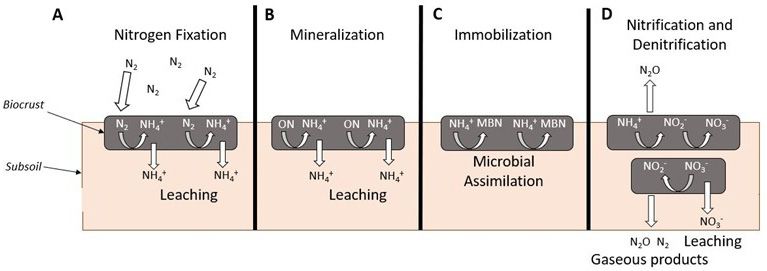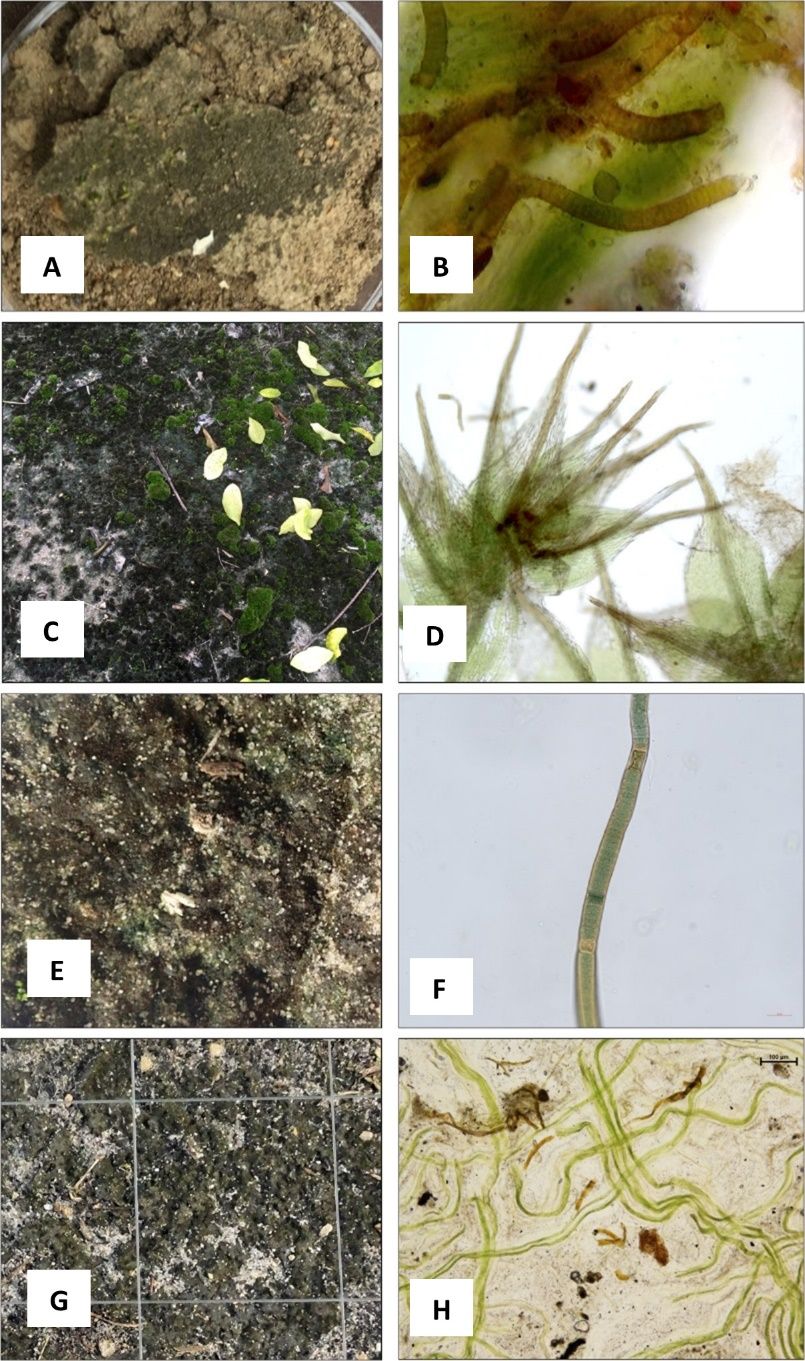What are biological soil crusts?
Biological soil crusts, also known as biocrusts, are communities of organisms that form on the soil surface. These communities are generally dominated by phototrophic organisms (i.e., those able to obtain energy from light), such as algae, mosses, and cyanobacteria (i.e., bacteria that obtain energy from photosynthesis). However, other bacteria, fungi, and lichens can also be part of a biocrust. Biocrusts can have several benefits to agroecosystems such as increasing moisture, carbon (C), and nitrogen (N) in the soil, with associated benefits for plants growing near biocrusts and overall soil health. This publication is intended to serve Extension agents and stakeholders who are interested in learning more about biocrusts, particularly those that have been identified in Florida agroecosystems.
Biocrusts are generally classified by the types of organisms present, surface roughness and coloration, thickness, and pigment concentration. There are two primary types of biocrusts (Figure 1). Thin biocrusts with smooth surfaces and light coloration are dominated by cyanobacteria not capable of fixing nitrogen (N). Thicker biocrusts with rough surfaces and dark coloration contain N-fixing cyanobacteria. The pigments in N-fixing cyanobacteria, lichens, and fungi contribute to the darker coloration of these biocrusts. Further biocrust development usually involves the introduction of fungi, lichens, and mosses. Comparatively, biocrusts with lichens and mosses are thicker than those with cyanobacteria.

Credit: Kira Sorochkina, UF/IFAS
Globally, biocrusts are commonly found in natural arid and semi-arid ecosystems, such as deserts. Natural ecosystem biocrusts can occupy areas where local conditions may not be favorable for plant growth. For example, biocrusts grow between plants in deserts of Israel, China, and the southwest United States and in semi-arid grasslands of the southwest United States and Spain. Biocrusts can also grow in areas with temporary dry conditions (i.e., mesic ecosystems), especially where plants are not adapted to those periods of limited rain. These biocrusts can be found in the savannahs of the United States and Australia, in Canadian grasslands, in Florida’s sandy soil systems, and in the seasonally flooded Florida Everglades. Both mesic and arid ecosystem biocrusts can range from light to dark classifications, but mesic biocrusts tend to have a larger proportion of mosses, lichens, and algae than their arid counterparts.
Why are biocrusts important to agroecosystems?
Biocrusts have increased moisture, organic matter, and nutrient contents compared to bare, non-crusted soil (Nevins, Strauss, and Inglett 2020b). In some ecosystems, soil below biocrusts has higher C, N, and water contents compared to nearby bare soil. The extent of these enrichments is dictated by biocrust type and the ecosystem it inhabits.
In some Florida sandy soil agroecosystems, biocrusts could improve soil health by contributing organic matter and nutrients to the soil. Other benefits to soil health could include increased soil moisture because the crust acts as a barrier on the soil surface, retaining rain and irrigation water. Biocrusts can absorb up to ten times their volume of water, potentially serving as a source of moisture for the soil below. Furthermore, microbial mucilage from biocrust organisms can act as a glue and bind soil particles together, reducing erosion and increasing retention of nutrients in the soil. The extent to which biocrusts in Florida agroecosystems impact soil health, including soil nutrient status, depends on numerous factors including type of agricultural system, management practices, type of biocrust, local climate, and soil type.
Nitrogen is an essential element required for life, including crop growth and development. Nitrogen fixation and mineralization by biocrusts can contribute N to the soil below crusts. Nitrogen-fixing microorganisms are specialized microbes that convert dinitrogen gas (N2) to ammonia (NH3). Other soil microorganisms can convert the NH3 in the soil to ammonium (NH4+) and nitrate (NO3-) (plant-accessible compounds that plants can absorb since they cannot get N from N2) (Nevins, Strauss, and Inglett 2020a). These N-cycling microbes are present in nearly all soils, though often at low abundances. Cyanobacterial biocrusts can be hotspots of N-fixing microorganisms, likely adding appreciable amounts of N to soils through N-leaching after N-fixation (Figure 2A, D). Other types of biocrusts, such as fungal, algal, and moss-dominated crusts, can act as slow-release sources of N. Just as dead plant residues mineralize and decompose at the soil surface, the organisms in these biocrusts mineralize organic N (ON) to NH4+, which can remain soluble in the soil environment and available for plant and microbial uptake (Figure 2B).
In addition to being a source of N (Nevins, Strauss, and Inglett 2022), in some cases biocrusts act as sinks of N. If biocrust organisms retain more N than they release to subsoil, the crust will immobilize N (Figure 2C). Nitrogen can also be lost from biocrusts during nitrification and denitrification (Figure 2D). During nitrification, the crust produces nitrous oxide, from a conversion of NH4+ to nitrite (NO2-) and nitrate (NO3-), which is released to the atmosphere. The crust can also produce and release nitrous oxide to the atmosphere during denitrification, where NO3- converts to N2. Additionally, N can be lost from the crust to the subsurface soil through leaching, where water from rain or irrigation can transport N to the soil below biocrusts (Figure 4A, D) (Nevins, Strauss, and Inglett 2021). The impact of biocrusts on N availability depends on several factors including biocrust type, soil type, agriculture system, climate, and season (Nevins et al. 2022). Ongoing research at UF/IFAS is investigating these factors.

Credit: Clayton Nevins, UF/IFAS
Where can you find biocrusts in agroecosystems?
Biocrusts grow in agroecosystems, but their formation is generally limited by disturbance and sun exposure. Currently, biocrusts have only been identified growing adjacent to perennial crops including grapes (Figure 3C), citrus (Figure 3A) (Nevins, Strauss, and Inglett 2020b), olive, and apple (Figure 3B). Both light and dark cyanobacterial biocrusts (Figure 1A, B) have been found under crop canopies in the United States. Nitrogen-fixing cyanobacteria have been detected microscopically in dark biocrusts of grape, citrus (Figure 4F), and apple (Figure 4B) agroecosystems.

Credit: A and C, Kira Sorochkina, UF/IFAS; B, Catherine Reardon, USDA-ARS
Biocrusts are highly sensitive to disturbance, which is likely why agroecosystem biocrusts mainly grow close to the crop and not in the row middles where there are disturbances to the soil by machinery or human foot traffic. Therefore, the frequent disturbances that occur in annual cropping systems likely limit biocrust growth. Because biocrusts are primarily composed of photosynthetic organisms, they are more commonly found in younger tree crops with small canopies that allow those photosynthetic organisms access to the sunlight they need to create energy. Areas in an orchard or grove with unmanaged weeds will also have relatively little biocrust growth, likely because of shading and competition for space.

Credit: Kira Sorochkina, UF/IFAS
Summary
Biocrusts are cooperative groups of various organisms (moss, algae, fungi, and bacteria) that can be found on soil surfaces in perennial agroecosystems. Biocrusts can mediate surface soil N cycling in these systems. They can potentially improve soil moisture, increase subsoil carbon and N, and affect soil microbial abundance (Nevins, Strauss, and Inglett 2020b; Nevins, Strauss, and Inglett 2021; Nevins et al. 2022). These biocrusts may also supply and regulate the flow of N and other nutrients to plants in agroecosystems (Nevins, Strauss, and Inglett 2022). While biocrust management in agroecosystems is an area of ongoing research and final recommendations for best practices have not yet been determined, we know that weed control is important. Preventing weeds from sharing the ground allows sunlight to reach the soil and thus help maintain photosynthetic biocrust organisms. Ongoing research will also further characterize biocrusts in perennial agroecosystems and their potential impact on nutrient cycling, crop nutrient uptake and growth, and soil health.
References
Nevins, C. J., S. L. Strauss, and P. W. Inglett. 2020a. “An Overview of Key Soil Nitrogen Cycling Transformations: SL471/SS684, 5/2020”. EDIS 2020 (3). https://doi.org/10.32473/edis-ss684-2020
Nevins, C. J., S. L. Strauss, and P. W. Inglett. 2020b. “Biological soil crusts enhance moisture and nutrients in the upper rooting zone of sandy soil agroecosystems.” Journal of Plant Nutrition and Soil Science. 183(5): 615–626. https://doi.org/10.1002/jpln.202000218
Nevins, C. J., S. L. Strauss, and P. W. Inglett. 2022. “Contrasting Effects of Agroecosystem Biocrusts on Seedling Growth and Nitrogen Accumulation in a Greenhouse Environment.” Agrosystems, Geosciences, and Environment. 5(3): e20295. https://doi.org/10.1002/agg2.20295
Nevins, C. J., P. W. Inglett, C. Reardon, and S. L. Strauss. 2022. “Seasonality drives microbiome composition and nitrogen cycling in soil below biocrusts.” Soil Biology and Biochemistry. 166: 108551. https://doi.org/10.1016/j.soilbio.2022.108551
Nevins, C. J., P. W. Inglett, and S. L. Strauss. 2021. “Biological soil crusts structure the subsurface microbiome in a sandy agroecosystem.” Plant and Soil. 462: 311-329. https://doi.org/10.1007/s11104-021-04868-2